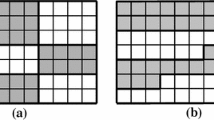Abstract
H.264/AVC is the latest standard for video compression and is a significant advance, but at the expense of increasing computing needs. Recently, the progress of GPUs has attracted considerable attention because they are able to offer practical and acceptable solutions for speeding up graphic and non-graphic applications. In this paper, we present an implementation of H.264/AVC Motion Estimation running on an NVIDIA GTX285 using CUDA. The algorithm is divided into three steps, all of which need to be executed sequentially but each one is exploited following a highly parallel procedure by using the GPU. The execution time of the proposed motion estimation algorithm is 53 times faster and it reduces the energy consumption by a factor of 9 compared with the JM reference encoder using a single CPU core.



Similar content being viewed by others
References
Wiegand T, Sullivan GJ, Bjontegaard G, Luthra A (2003) Overview of the H.264/AVC video coding standard. IEEE Trans Circuits Syst Video Technol 13(7):560–576
ISO/IEC International Standard 14496-10:2003. Information technology—coding of audio—visual objects. Part 10: advanced video coding
Feng W-C, Manocha D (2007) High-performance computing using accelerators. Parallel Comput 33:645–647
NVIDA (2011) NVIDIA CUDA compute unified device architecture programming guide. Version 4.0
Joint Video Team (JVT) of ISO/IEC MPEG and ITU-T VCEG (2009) Reference software to committee draft. JVT-F100 JM15.1. http://iphome.hhi.de/suehring/tml/
Kelly F, Kokaram A (2004) Fast image interpolation for motion estimation using graphics hardware. In: IS&T/SPIE electronic imaging—real-time imaging VIII, vol 5297, pp 184–194
Ho C-W, Au OC, Gary Chan S-H, Yip S-K, Wong H-M (2006) Motion estimation for H.264/AVC using programmable graphics hardware. In: Proceedings of IEEE international conference on multimedia and Expo, pp 2049–2052
Lee C-Y, Lin Y-C, Wu C-L, Chang C-H, Tsao Y-M, Chien S-Y (2007) Multi-pass and frame parallel algorithms of motion estimation in H.264/AVC for generic GPU. In: Proceedings of IEEE international conference on multimedia and Expo, pp 1603–1606
Chen W-N, Hang H-M (2008) H.264/AVC motion estimation implementation on compute unified device architecture (CUDA). In: Proceedings of IEEE international conference on multimedia and Expo, pp 679–700
Aliaga JI, Anzt H, Castillo M, Fernández JC, Heuveline V, Mayo R, Quintana ES (2011) Analysis and optimization of power consumption in the iterative solution of sparse linear systems on multi-core and many-core platforms. In: International workshop on power measurement and profiling
Sullivan G, Bjøntegaard G (2001) Recommended simulation common conditions for H.26L coding efficiency experiments on low-resolution progressive-scan source material. ITU-T VCEG Doc. VCEG-N81
Acknowledgements
This work was supported by the Spanish MEC and MICINN, as well as European Comission FEDER funds, under Grants CSD2006-00046 and TIN2009-14475-C04. It was also supported by the Council of Science and Technology of Castilla-La Mancha under Grants PEII09-0037-2328 and PII2I09-0045-9916.
Author information
Authors and Affiliations
Corresponding author
Rights and permissions
About this article
Cite this article
Rodríguez-Sánchez, R., Martínez, J.L., Fernández-Escribano, G. et al. H.264/AVC inter prediction for heterogeneous computing systems. J Supercomput 64, 79–88 (2013). https://doi.org/10.1007/s11227-012-0782-x
Published:
Issue Date:
DOI: https://doi.org/10.1007/s11227-012-0782-x




